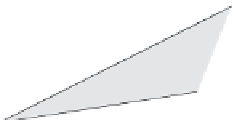Graphics Reference
In-Depth Information
Predicted line :
m
x
x
+
m
y
y
+
m
z
f
=0
Image plane
(
x
1
,
y
1
)
h
1
Camera
coordinate system
3D line
F
P
(
s
)
h
(
s
)
y
3D edge to
be recovered
Edge marked by
the user on the
captured image
m
Image edge
-
z
x
→
Direction of the edge:
v
Camera parameters
→
R
,
t
y
Position of
the edge:
→
-
z
x
Scene
coordinate system
h
2
(
x
2
,
y
2
)
(b)
Figure 5.10
Stereo reconstruction based on lines. (a) A line in the scene is specified by a direction
vector
v
and an off vector
d
in scene (world) coordinates, and it projects to a line on an
image plane. (b) A line predicted by the model is compared to the observed line in the
image plane. (After [Debevec et al. 96].)
(a)
included in the parameter set of the error optimization. The optimization problem
is nonlinear. The numeric algorithm employed requires a good initial estimate
for it to converge to the proper local minimum. The authors describe a method
for finding an initial estimate that works by first estimating the camera rotation
parameters. Equation (5.3) implies the constraints,
m
T
R
v
=
0
,
(5.4)
m
T
R
(
d
−
t
)=
0
.
(5.5)
Horizontal and vertical edges have a known orientation
v
. If there are enough of
these, as there probably are in any real architectural model, a least squares min-
imization of Equation (5.4) over all such edges provides a good estimate of all
the camera rotations. Once these are computed, the camera translations and re-
maining parameters are estimated by minimizing Equation (5.5). These estimates
serve as the initial guess for the numeric optimizer. Nonlinear optimization is not
easy, and gets harder with more parameters. For this reason, it is important that
the model at this stage is fairly simple. Geometric details are added to this initial
rough model in the final stage.




















































